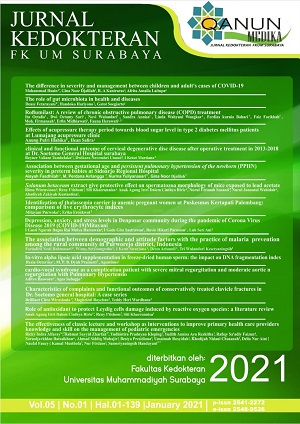Characteristics of complaints and functional outcomes of conservatively treated clavicle fractures in Dr. Soetomo general hospital: A case series
Abstract
ABSTRACT
Â
Shoulder pain is a major complaint of patients with clavicle fractures as a result of trauma. At present most clavicle fracture treatments are performed surgery, although conservative therapy can produce the same results. This report aimed to show whether there were complaints of shoulder pain or disability in patients who have suffered clavicle fractures treated conservatively. There were fifteen patients with clavicle fractures at Dr. Soetomo Surabaya from January to July 2015, consisting of 14 male and one female patient. Data was taken from medical records, patient clinical records, home visits, physical examinations, SPADI questionnaires, and Quick DASH for patients. The results of SPADI questionnaire were varied; there were eight patients (53%) with an output of 0%, one patient (7%) each with a score of 0.63%, 1.25%, 5.90%, 7.13%, 8.50%, 9.90%, and a score of 10.50%. The results of calculating the Quick DASH questionnaire score also varied. There were ten patients (67%) with a score of 0, three patients (20%) with a score of 2.27, one patient (7%) with a score of 13.6, and one patient (6%) with a score of 6.81. In conclusion: (1) From the evaluation of 15 patients, there were no complaints of pain and disability in the shoulder joint. (2) From the evaluation of the results of the calculation of the SPADI questionnaire and Quick DASH, there were no significant complaints of shoulder joint pain and disability. (3) The conservative treatment of closed fractures on the clavicle can still be a reliable choice of treatment.
Â
Keywords                : Clavicle fractures, shoulder pain, conservative clavicle.
Correspondence to: brijurnalqanun@gmail.com
Â
Â
Full text article
References
REFERENCES
Cutlip, K., Nimbarte, A. D., Chowdhury, S. K., & Jaridi, M. (2015). Evaluation of Shoulder Stability During Forceful Arm Exertions. Industrial and Systems Engineering Review, 3(1), 49–58.
Duncan, S. F. M., & Flowers, C. W. (2015). Clavicle Fracture. In Therapy of the Hand and Upper Extremity (pp. 47–48). Springer.
Ersen, A., Atalar, A. C., Birisik, F., Saglam, Y., & Demirhan, M. (2015). Comparison of simple arm sling and figure of eight clavicular bandage for midshaft clavicular fractures: a randomised controlled study. The Bone & Joint Journal, 97(11), 1562–1565.
Factor, D & Dale, B. (2014). Clinical commentary current concepts of rotator cuff tendinophaty. Int J Sports Phys Ther, 9(2), 274–288
Hoogervorst, P., & Schie, P. Van. (2018). Shoulder & Elbow Midshaft clavicle fractures : current concepts, EFFORT Open Reviews, 3(6). https://doi.org/10.1302/2058-5241.3.170033
Jha, G. K., Timsina, P., Yadav, D., Lamichhane, S., & Jha, S. (2018). Conservative Vs Operative Management of Displaced Midshaft Clavicle Fracture : A Comparative Study. Biomed J Sci & Tech Res, 5(4), 8293–8303. https://doi.org/10.26717/BJSTR.2018.11.002051
Lenich, A., & Imhoff, A. B. (2015). Fractures of the Clavicle. Sports Injuries: Prevention, Diagnosis, Treatment and Rehabilitation, 161–168.
Lenza, M., & Faloppa, F. (2016). Conservative interventions for treating middle third clavicle fractures in adolescents and adults. Cochrane Database Syst Rev, (12). https://doi.org/10.1002/14651858.CD007121.pub4.www.cochranelibrary.com
Liu, G., Tong, S., Ou, S., Zhou, L., Fei, J., Nan, G., & Gu, J. (2013). Operative versus non-operative treatment for clavicle fracture: a meta-analysis. International Orthopaedics, 37(8), 1495–1500.
Naveen BM, Joshi GR, & Harikrishnan, B. (2017). Management of mid-shaft clavicular fractures : comparison between non-operative treatment and plate fixation in 60 patients. Strategies in Trauma and Limb Reconstruction, 12(1), 11–18. https://doi.org/10.1007/s11751-016-0272-4
Phadnis, J., & Bain, G. I. (2015). Clavicle Anatomy. In Normal and Pathological Anatomy of the Shoulder (pp. 71–80). Springer.
Qvist, A. H., Væsel, M. T., Jensen, C. M., & Jensen, S. L. (2018). Plate fixation compared with non-operative treatment of displaced midshaft clavicular fractures: a randomized clinical trial. Bone Joint J, 100(10), 1385–1391.
Shettar, V. G., Bhasme, V. K., & Battur, M. N. (2018). Section : Orthopaedics Prospective Comparative Analysis of Functional Outcome of Operative – Titanium Elastic Nailing System ( TENS ) Versus Non Operative Treatment of Midshaft Clavicle Fractures Section : Orthopaedics, 5(9), 1–5.
Simon, P. (2009). Fractures and nonunions of the clavicle. In European instructional lectures (pp. 75–80). Springer.
Society, C. O. T. (2007). Non-operative Treatment Compared with Plate Fixation of Displaced Midshaft Clavicular Fractures. J. Bone Joint Surg Am, 89(1): 1–10.
Authors

Qanun Medika by FK UM Surabaya is liscence under Lisensi Creative Commons Atribusi 4.0 Internasional.

